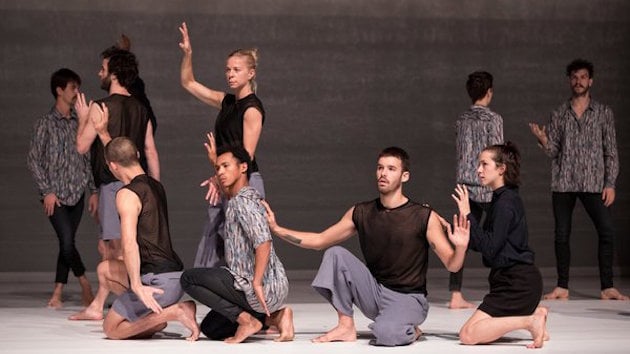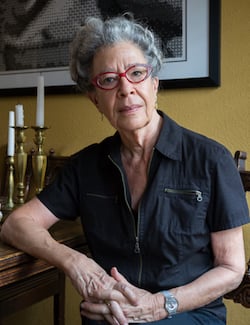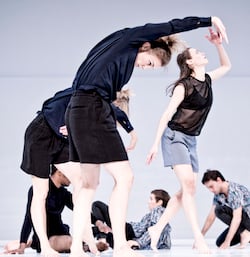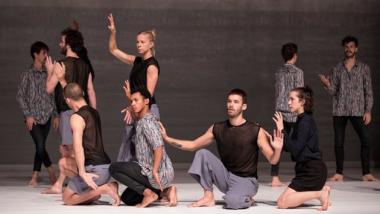
Sometimes a drawing or diagram is the best way to describe a dance. Or maybe a piece of paper with the words “see” and “dance” written on it, cut into a thousand pieces, tossed into the wind, regathered as best as is possible and put together to make an abstract puzzle in which the fractured forms are recognizable as parts of letters but construct a new language — maybe that would best describe choreographer Deborah Hay’s fascinating Figure a Sea.
Performed by the gifted and entirely focused Cullberg Ballet and presented by Cal Performances at Zellerbach Hall, the show’s two-hour lecture/dance format began with words, but aimed at a place where words have yet to be invented or are completely unnecessary. An original score by Laurie Anderson lent an expansive, hushed tone; mostly pulsing gently with simple, repeating three- or four-note motives or hovering like a cloud in sustained, electronic chords. Sometimes the score disappeared entirely to allow the pitter-patter of the dancers’ bare feet to emerge like soft rain falling on sand.
Offering stark and essential contrast to the work’s overall, ethereal expressivity, a white, rectangular floor and backdrop was placed center stage and illuminated by lighting designer Minna Tiikkainen to brilliant effect by a 21-light overhead grid. The white rectangles abruptly dissected the otherwise all-black space into bright and dark regions. Similarly solid and defining three groups of dancers, the slate blue, white, stone gray, and black shirt-and-pants costumes by Marita Tjärnström resembled concrete, or graffiti-covered granite, in the case of the scribble-filled lighter shirts worn by some of the cast.

Hay is notorious for posing questions — of the dancers in rehearsal and of the audience, indirectly, during performance. The answers are found in the body more than in language and in physical discoveries that lead to more questions, rather than to final conclusions or opinions. People who look for literal stories are left wanting, but if it’s poetry a person seeks, or her mindset is that of a scientist bent on uncovering the next unknown, Figure a Sea offers abundant possibilities.
And to Hay’s good fortune, the Cullberg’s 20 dancers (four guest artists join the company’s usual 16), are exceedingly intelligent, poetic physical beings. The burden to carry the work beyond what could have been simply an eclectic collection of impressive and pedestrian movements on the vast Berkeley stage fell almost entirely on the dancers’ shoulders. Invading every nook and cranny of the open-wings space, they moved rapidly through an impossible range of movements and positions that brought to mind marine animals, smoke from a wildfire, foam and fizz on a quickly poured beer, people queuing or waiting in line, and couples sleepily embracing or wandering through a park. They also managed to seamlessly weave the formality of ballet class exercises and standard modern-dance movements and floor work into the less stylized vocabulary of the piece.

Stillness was used to great effect, especially in timeless tableaux in which the dancers resembled Greek sculptures or a 21st-century video on pause. Unison was equally sparse, but effective, like when all the dancers pivoted to face the audience and all but the one couple, locked in an embrace, sidled offstage furtively, whispering and glancing at each other. Another time, after springing like young deer, they faced front, settled, and slowly lowered their uplifted arms, momentarily restoring peace.
Moments such as these made the dancers seem tribal, but given an hour to observe, it was a sense of 20 solos at once that was most striking. So rich were their investigations that it was easy to follow a single dancer, lose that dancer in the crowd, and pick up another dancer without feeling a sense of loss.
Watching a work by Hay allows audience members to discover how they see, what they look at, whether or not they are attached to front and center, if they zoom in on one dancer or prefer to open their focus to take in the panorama. For some of us, an overwhelming desire not to become or return to being a professional dancer but to get in there and feel what the dancers are feeling almost exceeds the visual impact. Any dance that makes a person want to dance — and art that causes an audience to expand their self-definition and leaves them with curiosity — is either exceptional or it is not your cup of tea. What is obvious about Hay’s work is that she draws a clear, minimalist line and leaves each person to decide where he or she exists.
During the 40-minute opening remarks, Hay spoke of experimenting with space, time, and seeing while she was involved with Judson Dance Theater in the 1960s. At the time, she and other modern dance “rebels” were highly influenced by composers such as John Cage and Robert Dunn and visual artists like Robert Rauschenberg. Jumping to the 2010s after decades investigating chance theories and improvisational approaches to dance — including the use of psychotropic drugs in the Sixties, she happily told the audience, who laughed appreciatively — has led Hay to find what she describes as greater “cellular consciousness.” Whether or not her engaging descriptions of continuity and discontinuity resonated or were made entirely clear by the whiteboard notes or a video that played while she was speaking was doubtful. What was apparent is that Hay has never stopped going to the edge. For a choreographer who claims no love of digital technology, prefers prose descriptions to video or dance notation for recording her choreography, and had never thought of working with a ballet company, Figure a Sea involved all of the above. It is one more example of Hay continuing to dive into discomfort and produce, improbably, works of infinite comfort, intelligence, and buoyancy.

